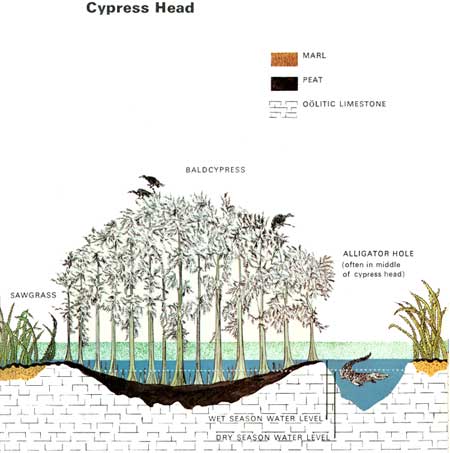|
EVERGLADES National Park |
 |
PLANT-AND-ANIMAL COMMUNITIES (continued)
Cypress Head
Standing out conspicuously on the glades landscape are tall, domelike tree islands of baldcypress. Unlike hammocks, which occupy elevations, cypress heads, or domes, occupy depressions in the limestone bedrock—areas that remain as ponds or wet places during seasons when the glades dry up. Water-loving cypresses need only a thin accumulation of peat and soil to begin their growth in these depressions or in smaller solution holes in the limestone.
Though most conifers retain their needles all year, baldcypresses shed their foliage in winter. The fallen needles decay, forming acids that dissolve the limestone further; thus these trees tend to enlarge their own ponds. Since the pond is deeper in the middle, and the accumulation of peat is greater there, the taller trees grow in the center of the head, with the smaller ones toward the edge. Hence the characteristic dome-shaped profile.
 CYPRESS HEAD. (click on image for an enlargement in a new window) |
Usually when fire sweeps the glades, the bald cypresses, occupying low, wet spots, are not injured. But with extended drought, the water disappears and the peat may burn for months, killing all the baldcypresses.
The cypress heads sometimes serve as alligator holes, where the big reptiles and other aquatic animals are able to survive dry periods. As you drive along the park road, stop and examine these tree islands through your binoculars; they are favored haunts of many of the park's larger wading birds. Look for herons, egrets, wood storks, and white ibis, which visit these swampy habitats to feed on the abundant aquatic life.
 TURKEY VULTURE. |
Bald eagles find the tops of the tallest cypresses advantageous perches from which to scan the marsh. And at night certain of the cypress heads are "buzzard roosts"—resting areas for gatherings of hundreds of turkey vultures.

|

|
| NPS History | History & Culture | National Park Service | Contact |
|
Last Modified: Sat, Nov 4 2006 10:00:00 pm PST |


